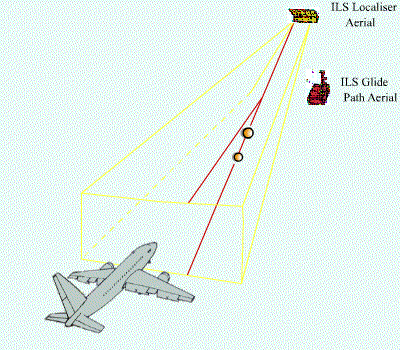Radio Landing Aids
 In the beginning the cockpit crew had only one reliance for landing an aircraft. to lookout for the runway and make approach for landing keeping Runway in view. Continued progression in the electronics, gifted the aviation industry with what can be termed as additional pair of eyes for the cockpit crew to be used when it is dark, foggy or otherwise a situation when visual reference may not be possible. ILS InstrumentThese are Precision Approach facilities, like PAR, ILS and MLS. PAR (Precision Approach Radar) had two Radar antennas one in vertical plane other in horizontal plane to give a continued picture of an aircraft in the approach path, indicating position of aircraft with reference to centerline of runway and its descent profile. However it needed a controller to give a running commentary to the pilot about his position with regard to runway, and was dependent on many things between pilot and his aircraft. That is, the Radar Equipment, the controller on ground using this Radar, Radio communication between aircraft and controller, pilot's more pressing need to attend to aircraft rather than to the rattling by the controller. All these were the drawbacks of PAR. however it gat replaced with ILS and MLS soon enough.
In the beginning the cockpit crew had only one reliance for landing an aircraft. to lookout for the runway and make approach for landing keeping Runway in view. Continued progression in the electronics, gifted the aviation industry with what can be termed as additional pair of eyes for the cockpit crew to be used when it is dark, foggy or otherwise a situation when visual reference may not be possible. ILS InstrumentThese are Precision Approach facilities, like PAR, ILS and MLS. PAR (Precision Approach Radar) had two Radar antennas one in vertical plane other in horizontal plane to give a continued picture of an aircraft in the approach path, indicating position of aircraft with reference to centerline of runway and its descent profile. However it needed a controller to give a running commentary to the pilot about his position with regard to runway, and was dependent on many things between pilot and his aircraft. That is, the Radar Equipment, the controller on ground using this Radar, Radio communication between aircraft and controller, pilot's more pressing need to attend to aircraft rather than to the rattling by the controller. All these were the drawbacks of PAR. however it gat replaced with ILS and MLS soon enough.
 ILS and MLS are essentially close to each other with exception of MLS being superior over ILS and is some conditions an option available when ILs can not be used. However both these are Pilot interpreted precision approach facilities. Meaning thereby these systems do not need a controller to give any rattling any more. The Equipment consists of two antenna transmitting radio beams in horizontal and vertical plane. An onboard radio receiver installed in the cockpit gives indication to the pilot about his position with reference to runway. This equipment follows the normal principle of cockpit instruments, follow the needle, that is if needle is down - go down, if needle is left - go left.
ILS and MLS are essentially close to each other with exception of MLS being superior over ILS and is some conditions an option available when ILs can not be used. However both these are Pilot interpreted precision approach facilities. Meaning thereby these systems do not need a controller to give any rattling any more. The Equipment consists of two antenna transmitting radio beams in horizontal and vertical plane. An onboard radio receiver installed in the cockpit gives indication to the pilot about his position with reference to runway. This equipment follows the normal principle of cockpit instruments, follow the needle, that is if needle is down - go down, if needle is left - go left.
